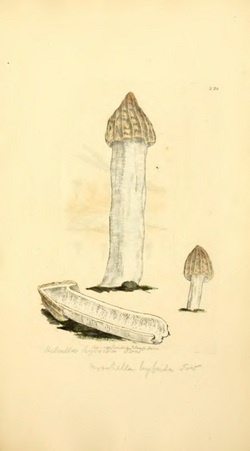Biology:Morchella semilibera
| Morchella semilibera | |
|---|---|

| |
| Illustration of a half-free morel, 1799 | |
| Scientific classification | |
| Domain: | Eukaryota |
| Kingdom: | Fungi |
| Division: | Ascomycota |
| Class: | Pezizomycetes |
| Order: | Pezizales |
| Family: | Morchellaceae |
| Genus: | Morchella |
| Species: | M. semilibera
|
| Binomial name | |
| Morchella semilibera DC. (1805)
| |
| Synonyms | |
|
Mitrophora semilibera (DC.) Lév (1846) | |
| Morchella semilibera | |
|---|---|
| Mycological characteristics | |
| smooth hymenium | |
| cap is conical or ovate | |
| hymenium attachment is irregular or not applicable | |
| stipe is bare | |
| spore print is cream to yellow | |
| ecology is mycorrhizal or saprotrophic | |
| edibility: edible | |
Morchella semilibera, commonly called the half-free morel, is an edible species of fungus[1] in the family Morchellaceae native to Europe and Asia.[2][3][4]
DNA analysis has shown that the half-free morels, which appear nearly identical on a macroscopic scale, are a cryptic species complex, consisting of at least three geographically isolated species.[5] Because de Candolle originally described the species based on specimens from Europe, the scientific name M. semilibera should be restricted to the European species.[2] In 2012, Morchella populiphila was described from western North America, while Peck's 1903 species name Morchella punctipes was reaffirmed for eastern North American half-free morels.[4] M. semilibera and the other half-free morels are closely related to the black morels (M. elata and others).[5]
A proposal has been made to conserve the name Morchella semilibera against several earlier synonyms, including Phallus crassipes, P. gigas and P. undosus. These names, sanctioned by Elias Magnus Fries, have since been shown to be the same species as M. semilibera.[6]
References
- ↑ Phillips, Roger (2010). Mushrooms and Other Fungi of North America. Buffalo, NY: Firefly Books. p. 364. ISBN 978-1-55407-651-2.
- ↑ 2.0 2.1 Kuo M. (April 2006). "Half-free morels (Morchella species)". MushroomExpert.com. http://www.mushroomexpert.com/morchella_half-free.html. Retrieved 2011-04-18.
- ↑ Gibson, Ian (2009). "Morels & False Morels of the Pacific Northwest: An Introduction". Pacific Northwest Key Council. http://www.svims.ca/council/Morels.htm. Retrieved 2011-04-18.
- ↑ 4.0 4.1 "Taxonomic revision of true morels (Morchella) in Canada and the United States". Mycologia 104 (5): 1159–77. 11 April 2012. doi:10.3852/11-375. PMID 22495449. http://thekeep.eiu.edu/cgi/viewcontent.cgi?article=1192&context=bio_fac.
- ↑ 5.0 5.1 "Phylogeny and historical biogeography of true morels (Morchella) reveals an early Cretaceous origin and high continental endemism and provincialism in the Holarctic". Fungal Genetics and Biology 48 (3): 252–265. Mar 2011. doi:10.1016/j.fgb.2010.09.006. PMID 20888422. https://naldc-legacy.nal.usda.gov/naldc/download.xhtml?id=49542&content=PDF.
- ↑ "Proposal to conserve the name Morchella semilibera against Phallus crassipes, P. gigas and P. undosus". Taxon 63 (3): 677–8. 2014. doi:10.12705/633.20. http://ascofrance.com/uploads/forum_file/Moreau-et-al-2014-proposal-Morchella-semilibera-Taxon-677-678-0001.pdf.
External links
Wikidata ☰ Q1795398 entry
 |

